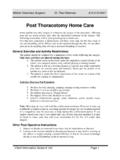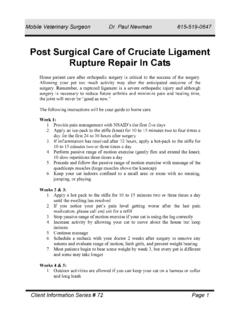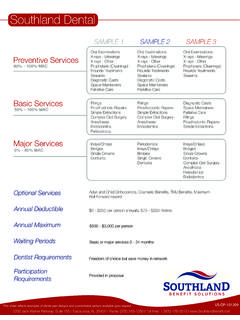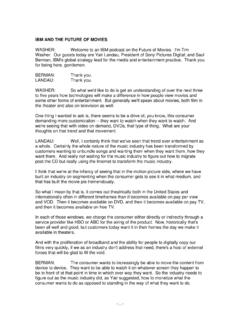Transcription of Fracture Repair With Splints and Casts - Mobile Vet …
1 Mobile Veterinary Surgeon Dr. Paul Newman 615-519-0647 Client Information Series # 74 Fracture Repair With Splints and Casts Except for simple greenstick fractures or simple, non-displaced fractures of the radius and tibia in young patients, utilizing Casts or Splints for Fracture treatment is never recommended. Internal fixation with pins, wires, plates or external fixators is always the best course of treatment to ensure fast healing with fewer complications. Splints and Casts are only utilized as a last resort when surgical intervention is not possible due to financial limitations or patient illness making anesthesia too risky.
2 Splints and Casts are responsible for many limb amputations due to cast disease where swelling, infection, or compromised circulation make saving the limb impossible. Dogs and cats can not tell us when swelling or numbness is occurring so early intervention is difficult in many cases. Our patients can not use crutches and therefore have to walk on the casted limb which can create sores and infection that are difficult to prevent. In most cases, surgically treated fractures will heal about 97% of the time without serious complications. When Casts or Splints are utilized, the rate of healing can be as low as 50% with the rate of cast disease reaching almost 95%.
3 If you have elected to utilize a cast or splint to treat your pet s fractured limb instead of surgical treatment, please be cautioned that catastrophic complications can occur. The purpose of this handout is to help you minimize these complications and increase the chance of success in your pet. The most important thing in minimizing complications is owner compliance. This means following all the instructions very carefully and coming back for frequent rechecks designed to catch any problems early on thereby preventing the most serious complications that can result from using Casts and Splints in animals.
4 Casted legs must be check twice daily for toe swelling, coldness of the toes, discharge, strike-through (discharge soaking through the cast or splint), and odors. Casts and Splints must be kept impeccably clean and dry and must be changed immediately if they get wet or dirty. If you have any questions, please ask your veterinarian. Splints and Casts Care of a splint or cast is very similar to that of a bandage except that they can cause even more serious complications. Obviously the purpose of a splint or cast is to hold a limb immobile so a Fracture or serious injury can heal. We like to avoid changing them too often to prevent unnecessary movement.
5 Because of this the owner must be very observant of the condition of the splint or cast . It should be changed or examined if it gets wet, seems loose, has strike through or gets chewed up. If the animal seems to be becoming progressively painful ( , limping or acting like it is bothering him/her excessively) the splint or cast should be checked by a veterinarian. Because of the rigid nature of the splint or cast , it is possible for pressure areas to become very ulcerated in spite of padding. This can happen quickly and the leg must be examined daily for drainage leaking through, the areas around the top getting raw and foul odors which may be Mobile Veterinary Surgeon Dr.
6 Paul Newman 615-519-0647 Client Information Series # 74 signs of infection and swelling. Frequent rechecks by a veterinarian are critically important when using a cast or splint. Missing even one recheck can have catastrophic consequences, even the loss of the limb. If you do not think you can find the time to come to the hospital on a regular basis for rechecks and cast changes, you should reconsider having internal fixation with surgery to Repair your pet s Fracture . Many times, when you add up the cost off frequent rechecks, cast changes, materials, sedation, and multiple radiographs to evaluate healing, the difference in cost between surgery and casting is not so great.
7 If you have any questions, please feel free to ask them at any time. Remember, if the cast gets wet, breaks, or the toes feel swollen or cold, this is an EMERGENCY and you should not wait until the next day to have it checked. Go to your local emergency clinic if your doctor is not available after hours.










